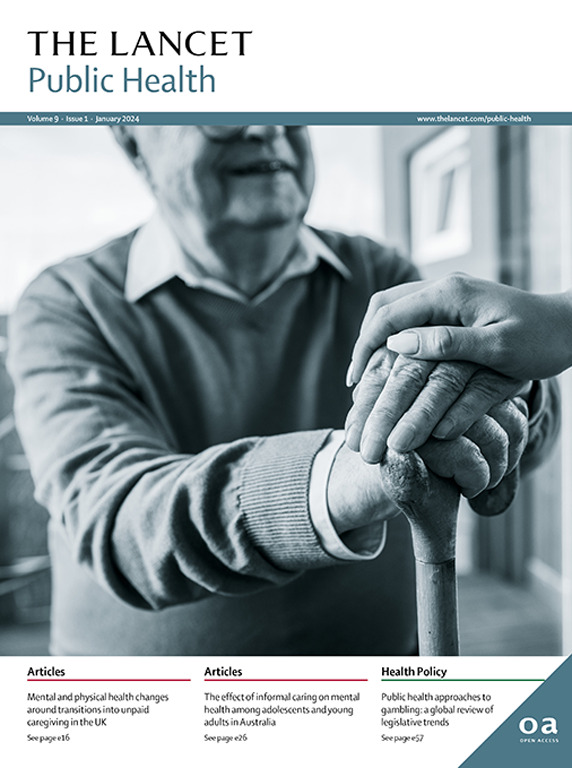工作场所干预对久坐行为和身体活动的影响:荟萃分析和叙事综合的综合综述
IF 25.4
1区 医学
Q1 PUBLIC, ENVIRONMENTAL & OCCUPATIONAL HEALTH
引用次数: 0
摘要
全球缺乏身体活动的情况正在上升,加剧了可预防的死亡和疾病的负担。尽管对促进工作场所的身体活动进行了广泛的研究,但由于各种各样的干预措施和结果,综合现有文献是具有挑战性的。本研究旨在提供全面的综合干预效果,为健康促进活动提供信息,并指导未来的研究工作。方法:本综述系统检索了6个数据库(Cochrane、MEDLINE、Embase、CINAHL、Scopus和Web of Science),检索了2000年1月1日至2024年5月31日期间发表的系统综述和荟萃分析,评估了针对18岁及以上无特殊健康状况或行动障碍的工作成年人久坐行为或身体活动的工作场所干预措施。结果包括任何与久坐行为或身体活动相关的行为改变。每个相关的干预措施和结果类别的证据组合使用荟萃分析或叙述综合进行总结,并根据需要提取主要研究数据。本研究已注册为PROSPERO, CRD42020171774。我们纳入了36项系统综述和荟萃分析,涵盖214项独特的主要研究。尽管证据存在相当大的异质性,但出现了几种中等至高可信度的效应趋势。首先,坐立两用工作站能最大限度地减少久坐时间,单独使用时每天最多减少75分钟(95% CI -109至-41),与心理社会策略配合使用时,减少时间最多可增加33%。然而,这些干预措施并没有显著增加任何强度的身体活动。第二,自我监控与心理社会策略相结合,使步数增加最多,平均每天增加1056步(371到1740)。第三,尽管现有的证据仍然很少,但没有特定的策略能够持续增加中等到剧烈的身体活动。还观察到其他趋势,但置信度较低。对发表偏倚的分析表明,环境水平的干预对职业久坐时间的影响是夸大的。使用修剪填充法对该偏差进行调整只会略微降低效应大小,但由于异质性高(I2=84·80%),因此应谨慎解释该结果。目前的证据强调了现有的工作场所干预措施对身体活动的适度影响。一些策略,如坐立工作站和游戏化干预,有效地减少了久坐行为,鼓励了较轻的体育活动,但没有一种策略能持续改善中等到剧烈的体育活动,而这种活动能提供最大的健康益处。由于许多国家未能实现世卫组织到2030年将缺乏身体活动的患病率从2010年的水平降低15%的具体目标,因此需要加紧努力解决这一差距,实现全球目标,并减轻缺乏身体活动造成的健康负担。本文章由计算机程序翻译,如有差异,请以英文原文为准。
Effects of workplace interventions on sedentary behaviour and physical activity: an umbrella review with meta-analyses and narrative synthesis
Background
Physical inactivity is rising globally, exacerbating the burden of preventable deaths and diseases. Despite extensive research on promoting physical activity in the workplace, synthesising the existing literature is challenging due to the wide variety of interventions and outcomes. This study aims to provide a comprehensive synthesis of intervention effects to inform health promotion initiatives and guide future research efforts.Methods
In this umbrella review, we conducted systematic searches of six databases (Cochrane, MEDLINE, Embase, CINAHL, Scopus, and Web of Science) for systematic reviews and meta-analyses published between Jan 1, 2000, and May 31, 2024, evaluating workplace interventions targeting sedentary behaviour or physical activity in working adults aged 18 years and older without specific health conditions or mobility impairments. Outcomes encompassed any behavioural changes related to sedentary behaviour or physical activity. Evidence for each relevant combination of intervention and outcome categories was summarised using either meta-analysis or narrative synthesis, with primary study data extracted as needed. This study is registered with PROSPERO, CRD42020171774.Findings
We included 36 systematic reviews and meta-analyses covering 214 unique primary studies. Despite considerable heterogeneity in the evidence, several effect trends emerged with moderate-to-high confidence. First, sit-to-stand workstations produced the largest reductions in sedentary time, decreasing it by up to 75 min per day (95% CI –109 to –41) when used alone, with reductions increasing by up to 33% when paired with psychosocial strategies. However, these interventions did not significantly increase physical activity at any intensity. Second, self-monitoring combined with psychosocial strategies yielded the largest increases in step count, with average gains of 1056 steps per day (371 to 1740). Third, no specific strategy consistently increased moderate-to-vigorous physical activity, although the available evidence remains sparse. Additional trends were observed but with lower confidence levels. Analysis of publication bias suggested an inflated effect of environmental-level interventions on occupational sedentary time. Adjusting for this bias using the trim-and-fill method only slightly reduced the effect size, but this result should be interpreted with caution due to high heterogeneity (I2=84·80%).Interpretation
Current evidence highlights the modest effect of existing workplace interventions on physical activity. Some strategies, such as sit-to-stand workstations and gamified interventions, effectively reduce sedentary behaviour and encourage lighter forms of physical activity, but none consistently improves moderate-to-vigorous physical activity, which provides the greatest health benefits. With many countries falling short of the WHO target to reduce physical inactivity prevalence by 15% from 2010 levels by 2030, intensified efforts are needed to address this gap, meet global goals, and alleviate the health burden of physical inactivity.Funding
None.求助全文
通过发布文献求助,成功后即可免费获取论文全文。
去求助
来源期刊

Lancet Public Health
Medicine-Public Health, Environmental and Occupational Health
CiteScore
55.60
自引率
0.80%
发文量
305
审稿时长
8 weeks
期刊介绍:
The Lancet Public Health is committed to tackling the most pressing issues across all aspects of public health. We have a strong commitment to using science to improve health equity and social justice. In line with the values and vision of The Lancet, we take a broad and inclusive approach to public health and are interested in interdisciplinary research.
We publish a range of content types that can advance public health policies and outcomes. These include Articles, Review, Comment, and Correspondence. Learn more about the types of papers we publish.
 求助内容:
求助内容: 应助结果提醒方式:
应助结果提醒方式:


